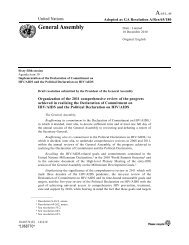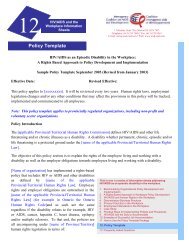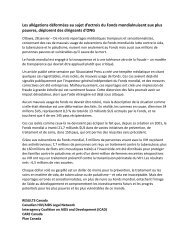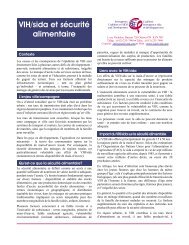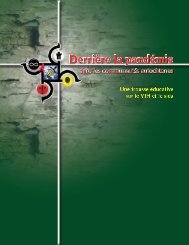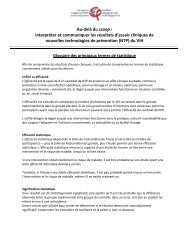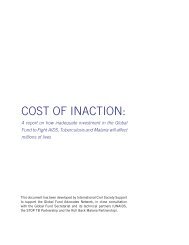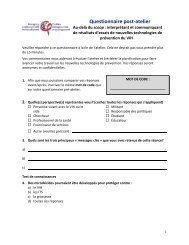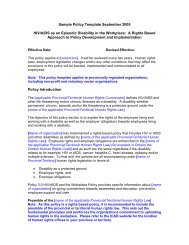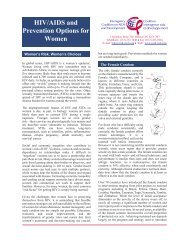Gender and Gender Inequalities• Gender norms and <strong>in</strong>equalities between men/boys and women/girls contribute toHIV epidemics around <strong>the</strong> world.• For Aborig<strong>in</strong>al women, gender cannot be viewed <strong>in</strong> isolation. Ra<strong>the</strong>r, it overlaps withrace and social location to produce <strong>in</strong>tense disadvantages rooted <strong>in</strong> <strong>the</strong> historicaland current marg<strong>in</strong>alization of Aborig<strong>in</strong>al women. In order for a gender analysis toapply to an Aborig<strong>in</strong>al context <strong>in</strong> a mean<strong>in</strong>gful way, a culturally relevant approach<strong>in</strong>corporates values and traditional teach<strong>in</strong>gs <strong>in</strong>tended to promote a greater degreeof equality between men and women.• A gender-balanced approach has more relevance with First Nations culturalphilosophies of traditional egalitarian societies and is a noble way to combatcolonization. Fur<strong>the</strong>rmore, traditional gender-balanced societies encourage respectfor all members of society - <strong>in</strong>clud<strong>in</strong>g women, men, boys, girls, elders, two-spiritedand transgender people.• Aborig<strong>in</strong>al women often make up a larger percentage of <strong>in</strong>dividuals test<strong>in</strong>g positivefor HIV. In Canada, Aborig<strong>in</strong>al women make up almost half of <strong>the</strong> HIV positivetests for which ethnic status is known. And <strong>in</strong> Canada’s poorest neighbourhood(Downtown Eastside, Vancouver), Aborig<strong>in</strong>al women liv<strong>in</strong>g with HIV are more likelyto die than o<strong>the</strong>r Vancouver women.• Gender comb<strong>in</strong>es with o<strong>the</strong>r social characteristics like age, race, and ethnicity tocreate poor health for Aborig<strong>in</strong>al women, girls, and transgender people.• Aborig<strong>in</strong>al women are often said to be <strong>the</strong> poorest of <strong>the</strong> poor. Women who lackeconomic security may have little power <strong>in</strong> <strong>the</strong>ir <strong>in</strong>timate relationships, or decide toengage <strong>in</strong> commercial sex work to make ends meet.Gender-based violence• Aborig<strong>in</strong>al women and girls face high rates of sexualized and racialized violence. This<strong>in</strong>cludes physical, emotional, and sexual abuse from an <strong>in</strong>timate partner or familymember; targeted violence aga<strong>in</strong>st Aborig<strong>in</strong>al sex workers; <strong>in</strong>timidation and verbalabuse; rape; and witness<strong>in</strong>g violence aga<strong>in</strong>st o<strong>the</strong>r Aborig<strong>in</strong>al women.• Internationally, Indigenous women are victims of sexual violence at alarm<strong>in</strong>g ratesand this can be viewed as an extension of on-go<strong>in</strong>g colonization, racism, militarism,displacement, and poverty-<strong>in</strong>duc<strong>in</strong>g models of economic development.• Attempts to address gender-violence must be created with <strong>the</strong> mean<strong>in</strong>gfulparticipation of Indigenous women <strong>the</strong>mselves based on <strong>the</strong>ir holistic vision ofwellness and socio-political realities.Child Welfare System• Many Aborig<strong>in</strong>al people who are liv<strong>in</strong>g with HIV and/or belong to groups particularlyvulnerable to HIV <strong>in</strong>fection (such as women, sex workers, <strong>in</strong>ject<strong>in</strong>g drug users andstreet-<strong>in</strong>volved youth) have been <strong>in</strong> foster care as children and youth.• Aborig<strong>in</strong>al children, specifically First Nations children, cont<strong>in</strong>ue to be overrepresented<strong>in</strong> <strong>the</strong> child welfare system of Canada.• Poverty, substance misuse, and poor hous<strong>in</strong>g are cited as key factors contribut<strong>in</strong>g to<strong>the</strong> elevated rates of Aborig<strong>in</strong>al children be<strong>in</strong>g placed <strong>in</strong> care. These factors must beunderstood <strong>in</strong> <strong>the</strong> broader structural context l<strong>in</strong>ked to <strong>the</strong> socio-economic conditionsof Aborig<strong>in</strong>al peoples, <strong>the</strong> results of which are not fully reflective of personal deficits.• Once placed <strong>in</strong> care, Aborig<strong>in</strong>al children often experience fur<strong>the</strong>r trauma. They82
may be cut off from <strong>the</strong>ir family, community, and culture, which <strong>in</strong> turn will lead tofeel<strong>in</strong>gs of abandonment, low self worth, and poor social skills, requir<strong>in</strong>g additionalsupport to prepare for success <strong>in</strong> adulthood.Mental Health, Substance Misuse and Addictions• Aborig<strong>in</strong>al communities have high rates of depression, suicide, substance misuse,and addictions. Aborig<strong>in</strong>al youth are particularly affected.• These high rates have been l<strong>in</strong>ked to historical and present day experiences ofcolonization and are made worse by racism and social and economic exclusion.• Some people turn to alcohol and drugs to cope with <strong>the</strong> immediate stresses of liv<strong>in</strong>g<strong>in</strong> poverty and <strong>the</strong> historical and present day <strong>in</strong>justices that limit <strong>the</strong>ir ability to earna dignified liv<strong>in</strong>g.• Substance misuse contributes to risky sexual behaviour, <strong>in</strong>clud<strong>in</strong>g unprotected sex.Access to Health Care• Many Aborig<strong>in</strong>al people live <strong>in</strong> rural and remote areas with limited access to Westernhealth care facilities and medical professionals such as physicians, dentists, nurses,nutritionists, and mental health professionals.• Most healthcare workers are tra<strong>in</strong>ed <strong>in</strong> <strong>the</strong> Western medical model, whichfocuses on <strong>in</strong>dividuals and biological aspects of health; <strong>the</strong>y may have a limitedunderstand<strong>in</strong>g of Aborig<strong>in</strong>al models of health and lack awareness of broader factorsaffect<strong>in</strong>g Aborig<strong>in</strong>al people’s health.• Medical professionals might also make harmful assumptions about Aborig<strong>in</strong>alclients. For example, <strong>the</strong>y might assume that all Aborig<strong>in</strong>al people have <strong>the</strong> samebeliefs and spiritual practices, and <strong>the</strong>refore offer one-size fits all <strong>in</strong>terventions.• Aborig<strong>in</strong>al people may distrust <strong>in</strong>stitutions based on experiences <strong>in</strong> <strong>the</strong> past thatdid not accommodate language skills, restricted visit<strong>in</strong>g hours, limited def<strong>in</strong>itions offamily and impeded access to spiritual support.• Aborig<strong>in</strong>al women face barriers access<strong>in</strong>g health and social services. They are morelikely to use services when <strong>the</strong>y are gender and culturally-sensitive. This <strong>in</strong>cludesreflect<strong>in</strong>g Aborig<strong>in</strong>al models of health and wellness, provid<strong>in</strong>g a welcom<strong>in</strong>g space forchildren, and ensur<strong>in</strong>g that women and <strong>the</strong>ir children are safe from abusive partners,police who have a warrant for <strong>the</strong>ir arrest or want to take away <strong>the</strong>ir children, ando<strong>the</strong>rs who may harm <strong>the</strong>m.Lack of Research on HIV and Aborig<strong>in</strong>al Peoples• Research is essential <strong>in</strong> HIV responses around <strong>the</strong> world. Decisions about policiesand fund<strong>in</strong>g are often guided by research about which groups are be<strong>in</strong>g <strong>in</strong>fectedwith HIV, how people are contract<strong>in</strong>g <strong>the</strong> virus, social and behaviour factors, andservice use.• The way conventional research is conducted is often rooted <strong>in</strong> Western models ofscience. These models ignore Aborig<strong>in</strong>al ways of know<strong>in</strong>g and explore issues thatmay not be a priority for Aborig<strong>in</strong>al communities. They may use research methodsthat are <strong>in</strong>compatible with Indigenous worldviews where reciprocity and respect arefundamental start<strong>in</strong>g po<strong>in</strong>ts for <strong>in</strong>quiry. Fur<strong>the</strong>rmore, <strong>the</strong> way that data is collected,<strong>in</strong>terpreted, and reported may hide or misrepresent key socio, economic, andcultural disparities with<strong>in</strong> Aborig<strong>in</strong>al communities.• It is possible for different worldviews to explore issues for mutual benefit, but <strong>the</strong>Indigenous Modelsof Health: Indigenouspeoples around <strong>the</strong> globe- <strong>in</strong>clud<strong>in</strong>g First Nations,Inuit and Métis with<strong>in</strong>Canada - have traditionalmodels of health andwellbe<strong>in</strong>g that are dist<strong>in</strong>ctfrom <strong>the</strong> biomedicalmodel commonly used<strong>in</strong> Western societies.These unique anddiverse outlooksmodels of health areshaped by <strong>the</strong> historical<strong>in</strong>terconnectednessto territory, physicalenvironment, language,traditional practices andaccess to resources ofeach Indigenous group.Common features ofIndigenous models<strong>in</strong>clude a holistic viewof health and well-be<strong>in</strong>gthat <strong>in</strong>cludes a balanceof four elements - <strong>the</strong>physical, spiritual,emotional and mental -and <strong>the</strong> understand<strong>in</strong>gthat <strong>the</strong> health of<strong>in</strong>dividuals and <strong>the</strong>health of communitiesare closely connected,reflect<strong>in</strong>g <strong>the</strong> collectiveperspective with<strong>in</strong>Indigenous beliefsystems.83
- Page 6 and 7:
Facilitator’s Materials..........
- Page 8 and 9:
What is this Educational Resource f
- Page 10 and 11:
experienced traumatic life events s
- Page 12 and 13:
Getting Ready to Facilitate this Ed
- Page 14 and 15:
Table 1: Potential Audiences and Ad
- Page 16 and 17:
Overview of Workshop AgendaOutlined
- Page 18 and 19:
WorkshopEtiquette(Social Norms)5 Mi
- Page 20 and 21:
Fred’s Story:LandscapeThinking(co
- Page 22 and 23:
Facilitator’s Note:It is possible
- Page 24 and 25:
Facilitator’s Note:Resiliency mea
- Page 27 and 28:
Participant MaterialsActivity Mater
- Page 29 and 30:
Individual LevelIndividual LevelInd
- Page 31 and 32: Family LevelIndividual LevelFamily
- Page 33 and 34: Family LevelFamily LevelFamily Leve
- Page 35 and 36: Community LevelCommunity LevelCommu
- Page 37 and 38: Community LevelCommunity LevelCommu
- Page 39 and 40: Systemic LevelSystemic LevelSystemi
- Page 41 and 42: Systemic LevelSystemic LevelSystemi
- Page 43 and 44: Systemic LevelSystemic LevelSystemi
- Page 45 and 46: Systemic LevelArmand’s StoryArman
- Page 47 and 48: Activity Materials: Resiliency Card
- Page 49 and 50: Community Healing and Self-Determin
- Page 51 and 52: Cultural ContinuityYou live in a co
- Page 53 and 54: Building Community CapacityEveryone
- Page 55 and 56: GIPA and ResearchA few years ago, t
- Page 57: Handout #1: HIV Basics 11CATIE. 201
- Page 62 and 63: 10/21/2010Activity Purpose• Incre
- Page 65 and 66: 9/27/2010Activity InstructionsActiv
- Page 67 and 68: 9/27/2010Questions for Vulnerabilit
- Page 69 and 70: 9/27/2010Fred’s StoryHas no fridg
- Page 71 and 72: 9/27/2010Understanding Health Inequ
- Page 74 and 75: 9/27/2010Root Causes: BroaderDeterm
- Page 76 and 77: 9/27/2010Broader Determinants ofAbo
- Page 80 and 81: Facilitator’s Note:These backgrou
- Page 84 and 85: approach must be undertaken with in
- Page 86 and 87: through collaboration and shared re
- Page 88 and 89: Diagram 1: Factors that affect HIVv
- Page 90 and 91: Card Key Issues Affecting Vulnerabi
- Page 92 and 93: Card Key Issues Affecting Vulnerabi
- Page 94 and 95: Card Key Issues Affecting Vulnerabi
- Page 96 and 97: Individual LevelIssue Exploration T
- Page 99 and 100: Card Key Protective Factors Suggest
- Page 101 and 102: Card Key Protective Factors Suggest
- Page 103 and 104: Glossary
- Page 105 and 106: Gender norms refer to the expectati
- Page 107 and 108: About the AuthorsLia De Pauw, MHSc,
- Page 109 and 110: Bouey, Paul D., and Betty E. S. Dur
- Page 111 and 112: Public Health Agency Health of Cana
- Page 113 and 114: Mill, Judy E., Randy C. Jackson, Ca
- Page 115 and 116: Scanlon, K., Travers, R., Humberto,



